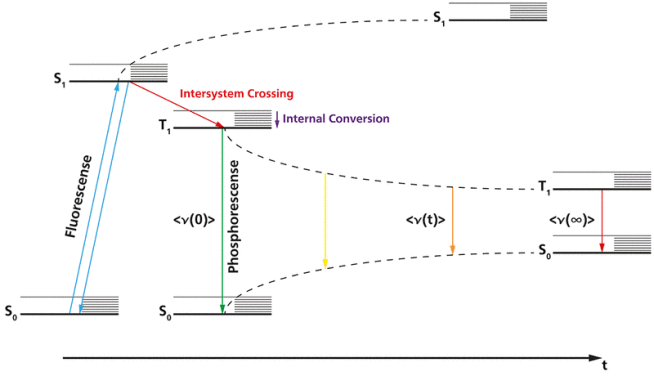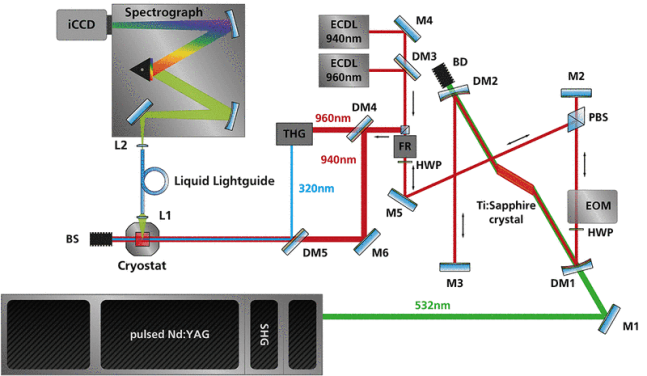
As in dielectric spectroscopy (DS), triplet solvation dynamics (TSD) measures the reorientation of the molecular dipoles of a liquid as a response to an electric field. The difference lies in the generation of the electric field. Instead of applying a macroscopic electric field over the entire sample, the field is generated locally in the sample itself. This is done by adding a dye to the sample in a very low concentration. When pumping the dye with a pulsed UV Laser, it can be excited to a long-lived triplet state. Since the dipole moment of the triplet state differs from the ground state dipole moment, the surrounding liquid molecules start to reorient in response to the changed electric field of the dye molecule. Due to the relaxation of the surrounding liquid, a Stokes shift of the emission wavelength of the dye occurs, which can be measured in the time range from 1 ms to 1 s by time-resolved optical spectroscopy [1]. The spatial range of TSD is limited to the first solvation shell around the dye, making it possible to measure the relaxation dynamics locally in confinements of a few nanometres.
References
- Richert, R. (2000). Triplet state solvation dynamics: Basics and applications. The Journal of Chemical Physics, 113 (19), 8404. doi:10.1063/1.1319174
The dye is excited to the triplet state by the third harmonic of a pulsed Nd:YAG laser at 355nm. To avoid bleaching of the dye the pulses are attenuated down to 4 mJ. The sample is mounted in a contact gas cryostat and can be tempered in the range from 320K to 77K. The emitted light is collected under 90° to the incident laser beam by a liquid light guide fiber. The output of the fiber is collimated into a grating spectrograph. An Intensified-CCD (iCCD) is used to record the time-resolved emission wavelength of the dye.
The accessible time range is limited by two different processes. At the long end it is limited only by the lifetime of the excited state. At the short end it is limited by the fact that a direct population of the triplet state from the singlet ground state is prohibited for optical excitation.
This can be overcome by employing a two-photon excitation. Two possible techniques are the Stimulated Emission Pumping (SEP) and the STimulated Raman Adiabatic Passage (STIRAP) . For both excitation schemes it is necessary that the two laser pulses have a low timing jitter and a small spectral bandwidth. Therefore, we are building up a regenerative Ti:Sapphire amplifier, which allows the synchronous amplification of two different wavelengths [2]. The seed lasers for the amplifier consist of two external cavity diode lasers (ECDL), which run at 940nm and 960nm. After the amplification, the 960nm radiation is frequency tripled to 320nm. The timing between the two pulses is tuned by a simple optical delay line. The two-photon excitation promises both higher signal-to-noise and the observation of TSD at timescales far below 1ms.
References
- Bergmann, K., Theuer, H., & Shore, B. (1998). Coherent population transfer among quantum states of atoms and molecules. Opens external link in new windowReviews of Modern Physics, 70(3), 1003–1025.
- Tian, C., Walther, T., Nicolaescu, R., Pan, X. J., Liao, Y., & Fry, E. S. (1999). Synchronous, dual-wavelength, injection-seeded amplification of 5-ns pulses in a flash-lamp-pumped Ti:sapphire laser. Optics Letters, 24(21), 1496–1498.

Generalized excitation scheme for Triplet Solvation Dynamics

Advanced experimental setup for two-photon excitation
Since the main components of the basic setup are commercially available, it is already possible to measure the TSD of supercooled liquids and compare the results to those achieved with dielectric spectroscopy and NMR.
Both seed lasers for the Ti:Sapphire amplifier are already set up and ready for operation. They provide 120mW at 940nm and 220mW at 960nm. The mode-hop free tuning range is 35GHz for the 940nm ECDL and 27GHz for the 960nm ECDL.
The next steps will include the setup of the regenerative amplifier at 960nm, the extension to dual-wavelength operation and generation of the required UV pulses at 320nm.








